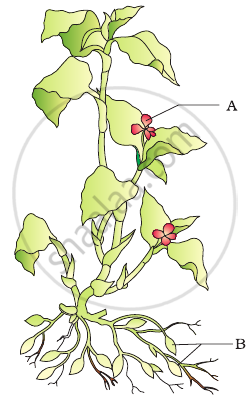Advertisements
Advertisements
प्रश्न
Find an odd one out.
पर्याय
Budding
Regeneration
Binary fission
Fragmentation
उत्तर
Binary fission
APPEARS IN
संबंधित प्रश्न
For binary fission, Amoeba required .................... parent cells.
(a) Three
(b) Two
(c) One
(d) Zero
Students were asked to observe the permanent slides showing different stages of budding in yeast under high power of a microscope.
(A) Which adjustment screw (coarse/fine) were you asked to move to focus the slides?
(B) Draw three diagrams in correct sequence showing budding in yeast.
How does multiple fission occur in an organism? Explain briefly.
Explain the process of regeneration in Planaria.
List two advantages of vegetative propagation.
Draw in sequence (showing the four stages), the process of binary fission in Amoeba.
Describe reproduction by spores in Rhizopus
State whether the following statement is true or false :
Spores produced by the bread mould plant are actually its seeds.
Name the artificial propagation mehod used for the propagation of apple trees.
Name two plants which are usually propagated by artificial propagation methods. Name the method of artificial propagation used in each case.
Describe the layering method for the artificial propagation of plants. Illustrate your answer with the help of a labelled diagram. Name any five plants which are propagated by the layering method.
What is meant by the term 'fission' as used in biology?
Why do green grass plants spring up in dry fields on their own after the rains?
What is meant by multiple fission? Name one organism which reproduces by the process of multiple fission.
Name two marine organisms which also reproduce by the same method as yeast but form colonies.
Define 'stock' and 'scion'.
What care should be taken while making a cutting from a plant?
Vegetative propagation refers to the formation of new plants from the following existing organs of the old plants :
(a) stems, roots and flowers
(b) stems, roots and leaves
(c) stems, flowers and fruits
(d) stems, leaves and flowers
Spore formation is the most common asexual method of reproduction in :
(a) protozoa
(b) tubers
(c) fungi
(d) algae
When a moist slice of bread was kept aside for a few days then some organism grew on it to form a white cottony mass which later turned black. When this slice of bread was observed through a magnifying glass, then fine thread-like projections and thin stems having bulb-like structures at the top were seen.
(a) What is the common name and scientific name of the organism which grew on the moist slice of bread?
(b) How did this organism grow on the moist slice of bread automatically?
(c) What are the fine, thread-like projections on the surface of slice of bread known as?
(d) What name is given to the knob-like structures and what do they contain?
(e) What is the name of this method of reproduction?
(f) Name one unicellular organism which reproduces by this method.
(g) Name tow non-flowering plants which reproduce by this method.
A worm X found in freshwater and slow-moving streams has been accidently cut into three pieces. It was observed that in due course of time, each cut piece of the worm develops to become a complete worm by growing all the missing parts.
(a) Name the worm X which can exhibit this phenomenon of making complete worm from its cut body parts.
(b) Name another organism Y which possesses the same characteristic of growing fully from its cut body parts.
(c) What is the name of this process in which a complete organism is formed from its cut body part.
(d) State whether X and Y are unicellular and/or multicellular organisms.
(e) Can a dog be produced completely form its cut body part (say, a cut tail) just like organisms X and Y? Why?
A filamentous alga X is found in ponds, lakes and slow-moving streams. The filament of this alga simply breaks into two (or more) pieces on maturing and each piece then grows to become a complete new alga.
(a) Name an alga which X is likely to be.
(b) What is the colour of X?
(c) What is the method of forming new algae by the breaking of parent alga known as?
(d) An Amoeba also breaks up to form two daughter Amoebae. What is the difference in the splitting of Amoeba and splitting of this alga as a method of reproduction?
(e) Name one marine animal which reproduces in the same way as alga X.
Put a tick mark (✓) against the correct alternative in the following statement
Grafting is a method of:
What is vegetative reproduction?
With the help of suitable diagram, describe Budding in yeast cell.
State whether the following statement IS true (T) or false (F):
Asexual reproduction is more common than the sexual reproduction.
Define the following:
Vegetative reproduction
Mention the common method of reproduction in Gladiolus.
Describe the various methods of vegetative reproduction.
What happens when a mature spirogyra filament attains considerable length?
What is fragmentation in organisms?
What is regeneration in organism?
Which of the following is a mode of asexual reproduction?
Rewrite the following statement by selecting the correct option.
When Hydra becomes matured, _________ takes place in it.
Give the name of the plant that reproduces vegetatively by: Underground stem
What is micropropagation?
A method in which roots are induced on the stem while it is still attached to the parent plant is called
Spirogyra reproduce by ______
In the figure given below the plant bears two different types of flowers marked ‘A’ and ‘B’. Identify the types of flowers and state the type of pollination that will occur in them.

Name the asexual reproductive structure of Chlamydomonas.
